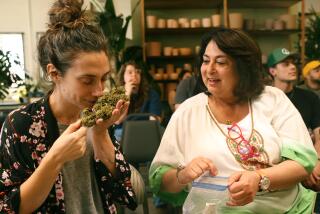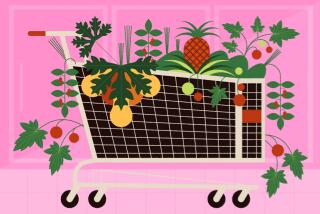GARDENING : Starting From Scratch : Growing your plants from seeds not only saves money but allows you to select from unusual varieties.
- Share via
I started growing flowers and vegetables from seed many years ago, because I was too cheap to spend $1 on a plant when I could spend $1 for a little envelope containing 30 to several hundred potential plants. But I continued growing from seed because I loved it: finding unusual varieties that nobody else was trying, waiting for the first tiny specks of green to show their heads, thinning to the strongest, nurturing, coddling, fussing--and then, finally, eating it or, if it was a flower, cutting it for the table. There isn’t much in life that can offer so much entertainment for so long and so little.
My first seeds were planted in plastic pony packs left over from a nursery purchase. I still have some of those six-well packs, and I still use them when I run out of my newer, fancier seed-growing toys. But now I have a greenhouse, and I buy huge industrial-size packages of seed-growing medium, which I usually put into spiffy self-watering containers or peat pots. I save seeds from my own plants, when practical. OK, I’m obsessed. But I’m happy.
First, the seeds. Don’t limit yourself to those at the local nursery. Get catalogues from a few seed companies, sit back, read and compare. Want to grow rainbow peppers? Stokes has a remarkable selection of red, yellow, gold, orange, purple, lavender, brown and ivory bell peppers. Plus many chiles. Heirloom tomatoes? Try one of the seed companies that specializes in open-pollinated heirlooms, such as Southern Exposure and Bountiful Gardens. Shepherd’s Garden Seeds has European varieties, with a large selection of basils, regular and scented. Stokes, Burpee and Park are general interest, with a little of everything. The Cook’s Garden focuses on lettuce and salad ingredients. Some companies specialize in Asian vegetables (Y.H. Evergreen), Southwest Indian crops (Native Seed Search), even tomatoes (Tomato Growers Supply Co.).
The containers: If you want to start out inexpensively, use recycled yogurt or tofu containers or clear plastic takeout cartons with attached lids (these make neat little mini-greenhouses), being careful to punch holes in the bottoms with a nail. Good drainage is essential. I grow most of my seeds in the APS system from Gardener’s Supply Co., because they are virtually self-watering. A plastic-foam container holds water, which is wicked up to the plants by a piece of felt fabric. When the plants are big enough to set out, they are easy to remove because each well has a small hole in the bottom; I just poke the little plants up and out. For plants that don’t like transplant shock, such as squash, melons and cucumbers, I use 3-inch peat pots. When they are ready to go into the soil outdoors, be sure to tear away any part of the peat pot that sticks above ground; if you don’t, it will act as a reverse wick, sucking moisture from the plant.
Watering: If you are using a container other than APS, remember to check the infants every day because you will probably have to water at least once a day, especially peat pots. Don’t just plunk them down in a pool of water; waterlogged seeds rot. The best seed-watering utensil is a can with a long neck and a fine mister-sprayer metal tip, called a rose. A spray bottle is OK, if you can stand to squeeze the trigger over and over and over.
The medium: Potting soil is for grown-up house plants; it doesn’t have the fine, light texture or strong nutrient boost that seeds need. I use a fine mix, almost like dust, available from Shepherd’s Garden Seeds. It is not cheap. Less expensive but also good are Parks Sow & Grow and Jiffy Mix from Stokes. I don’t fertilize until the plants are about 3 or 4 inches tall, and then I use fish emulsion. It smells bad and it clogs the pores of my watering can’s rose, but it’s organic; I understand what’s in it.
Temperature: A summer plant doesn’t care if its leaves are cool, so long as its roots are warm. If you are growing your seeds in a sunny window, they should be fine on all but the coldest nights, when you might want to bring them into the room. If you have an unheated greenhouse like mine, I strongly recommend a special seed-growing heating pad.
Timing: Start summer crops--tomatoes, eggplants, peppers, squash, cucumbers--indoors soon. Once your indoor seeds have reached adolescence--two or more sets of true leaves (the two little leaves that first emerge don’t count)--put them outside every day for a few days before they go into the ground (but bring them in at night). This will toughen them up for their entry into the real world of cold air, bugs, slugs, cats and pounding rain.
Put them into the garden when nighttime temperatures reach 50 or higher. I plant beans directly into the soil about the same time.
Variety: If all this seems like a lot of work, and if those 4-inch pots at the nursery are looking better and better, go ahead and buy them. But while you’re tucking in another boring old Celebrity, Big Boy or Beefsteak tomato, I will be enjoying Big Rainbow (an heirloom beefsteak, apricot-gold with a pink-red center and blush), Brandywine (a burgundy heirloom with deep grooves), Lemon Boy (bright yellow) and Stupice (from Poland, a potato-leaf type). Also St. Pierre, Green Pineapple, Marvel Stripe, June Pink, Costoluto Genovese and orange Valencia. Besides tomatoes, I’m going to grow five kinds of summer squash/zucchinis, four winter squash, peppers in all those colors mentioned earlier, five chiles, French beans, heirloom pole beans, asparagus (yard long) beans. And cornichon cucumbers and French melons.
My philosophy of life: If you’re going to have an obsession, it might as well feed you.
Seed Sources Park Seed Co.: Cokesbury Road, Greenwood SC 29647-0001 Stokes Seeds Inc.: Box 548, Buffalo NY 14240 W. Atlee Burpee & Co. Inc.: Warminster PA 28974 Evergreen Y.H. Enterprises: P.O. Box 17538, Anaheim CA 92817 The Cook’s Garden: Box 65, Londonderry VT 05148 (Catalogue: $1) Bountiful Gardens: 5798 Ridgewood Road, Willits CA 95490 Tomato Growers Supply Co.: P.O. Box 2237, Fort Myers FL 33902 Shepherd’s Garden Seeds: 30 Irene St., Torrington CT 06790 (Catalogue $1) Southern Exposure Seed Exchange: P.O. Box 158, North Garden VA 22959 (Catalogue: $3) Native Seeds/SEARCH: 2509 N. Campbell Ave., No. 325, Tucson AZ 85719 Gardener’s Supply Co.: 128 Intervale Road, Burlington VT 05401






